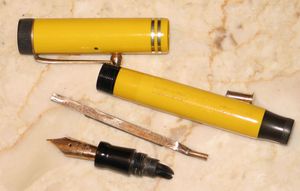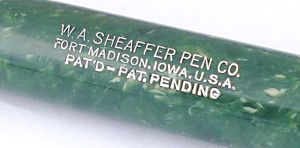Barrel

The barrel, or body is usually the largest part of a fountain pen. In modern cartridge filled pens it has practically no other role than to provide support for the use of the pen and cover the cartridge, but initially, when the pens were loaded with droppers, it was used directly as an ink tank. This role is still played today with some filling systems such as the piston filler or plunger filler, in which case it is often equipped with transparent parts (windows or entire sections) to allow the display of the ink level.

Even when the ink is not contained directly in the barrel, or in a part of it, but in a separate tank, as with all loading systems that use a rubber bag, the body still plays the role of container both for the latter and for the filling mechanism itself. Moreover, especially in the productions up to the '40s, it was typical to find the engravings of the brand and of the name of the producer (as well as of the possible patents of the pen).
Inizialmente, anche per la maggiore facilità di lavorazione, era realizzato in forma cilindrica con estremità piatte (il cosiddetto flat top) ma in seguito all'evolversi delle tendenze stilistiche si è passati a forme più affusolate (con la nascita del cosiddetto stile streamlined). Inoltre con l'evolversi delle tendenze stilistiche dalla ordinaria sezione rotonda si è passati a forme sfaccettate, triangolari, quadrate, ottagonali, dodecagonali, ecc.
Oltre al differenziarsi per le varie forme adottate dai produttori, il corpo ha subito anche l'evoluzione nell'uso dei materiali impiegati nella costruzione delle stilografiche, di cui appunto costituisce il componente più grande. Agli albori delle stilografiche era prevalentemente costruito in ebanite come il resto della penna, materiale che garantiva, dovendo servire da serbatoio dell'inchiostro, la necessaria resistenza chimica.
Con lo sviluppo della tecnologia sono stati utilizzati poi tutti gli altri materiali, a partire dal metallo (le prime furono probabilmente le Wahl Metal Pen), alle prime resine artificiali come bachelite, galalite e celluloide, per passare negli anni '40 alle più comuni resine plastiche in uso ancora oggi.